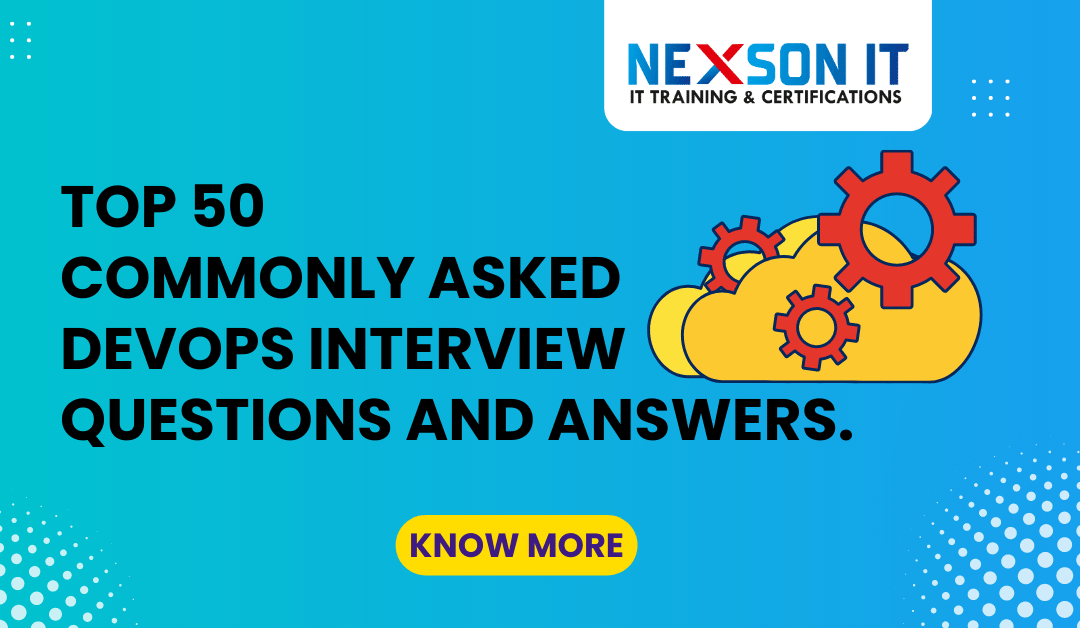Here is a list of the Top 50 commonly asked DevOps interview questions and their answers:

1. What is DevOps?
- DevOps is a culture and practice that aims to improve collaboration and communication between development and operations teams, with the goal of delivering high-quality software faster and more reliably.
- What are the benefits of using DevOps?
- The benefits of DevOps include faster software delivery, improved collaboration and communication between teams, better software quality, increased agility, and reduced time to market.
- What are the key principles of DevOps?
- The key principles of DevOps include automation, collaboration, continuous delivery and integration, continuous testing, and monitoring.
- What is continuous integration in DevOps?
- Continuous integration is the practice of merging code changes into a single codebase multiple times a day and automatically building and testing the software to ensure it is always in a releasable state.
- What is continuous delivery in DevOps?
- Continuous delivery is the practice of automatically building, testing, and deploying code changes to production, allowing teams to release software faster and more frequently.
- What is continuous testing in DevOps?
- Continuous testing is the practice of automatically testing code changes as they are committed, ensuring that bugs and issues are detected early and that the code is always in a releasable state.
- What is configuration management in DevOps?
- Configuration management is the practice of automatically managing and maintaining the configuration of software systems, ensuring that they are consistently deployed and remain in a desired state.
- What is infrastructure as code in DevOps?
- Infrastructure as code is the practice of managing and provisioning infrastructure using code and automation tools, rather than manual configuration.
- What is containerization in DevOps?
- Containerization is the practice of packaging software applications into containers, making it easier to deploy and manage them consistently across different environments.
- What is microservices in DevOps?
- Microservices is an architecture pattern where a software application is broken down into smaller, independent services that can be developed, deployed, and managed independently.
- What is continuous deployment in DevOps?
- Continuous deployment is the practice of automatically deploying code changes to production as soon as they pass automated testing, without requiring manual approval.
- What is continuous feedback in DevOps?
- Continuous feedback is the practice of actively seeking and incorporating feedback from all stakeholders, including customers, development, and operations teams, to continuously improve the software delivery process.
- What is version control in DevOps?
- Version control is the practice of tracking and managing changes to software code over time, allowing teams to collaborate on code development and revert to previous versions if necessary.
- What is Git and why is it used in DevOps?
- Git is a distributed version control system that is widely used in DevOps to manage and track code changes. It allows teams to collaborate on code development and revert to previous versions if necessary.
- What is Agile in DevOps?
- Agile is a development methodology that emphasizes collaboration, flexibility, and rapid iteration, with the goal of delivering software faster and more efficiently. It is often used in combination with DevOps practices.
- What is Scrum in DevOps?
- Scrum is an Agile framework for software development that emphasizes teamwork, iteration, and continuous improvement. It is often used in DevOps to manage and deliver software projects.
- What is Kanban in DevOps?
Kanban is a visual system for managing work in software development, emphasizing the flow of work and continuous delivery. It is often used in DevOps to visualize the workflow and prioritize tasks.
- What is the role of automation in DevOps?
- Automation is a key principle in DevOps, allowing teams to automate repetitive tasks, reduce errors, and speed up the software delivery process. Automation can be applied to various stages of the software development lifecycle, such as testing, deployment, and infrastructure management.
- What is the difference between Continuous Integration and Continuous Deployment?
- Continuous Integration (CI) is the practice of merging code changes into a single codebase multiple times a day and automatically building and testing the software. Continuous Deployment (CD) is the practice of automatically deploying code changes to production as soon as they pass automated testing, without requiring manual approval. While CI focuses on integrating code changes and ensuring they are in a releasable state, CD focuses on automatically deploying code changes to production.
- What is a release pipeline in DevOps?
- A release pipeline is a series of stages that code changes go through from development to production, including build, test, and deployment. The release pipeline is automated, allowing teams to deliver software faster and more reliably.
- What is a continuous integration/continuous deployment (CI/CD) pipeline?
- A CI/CD pipeline is a series of automated processes that integrate code changes, build and test the software, and deploy it to production. The CI/CD pipeline allows teams to deliver software faster and more reliably, and is a key component of DevOps.
- What is a build in DevOps?
- A build is the process of compiling and packaging software code into a deployable artifact, such as a binary or a Docker container. Builds are automated in DevOps, allowing teams to compile and package code changes quickly and consistently.
- What is a deployment in DevOps?
- A deployment is the process of delivering software changes to a production environment. Deployments are automated in DevOps, allowing teams to deliver software faster and more reliably.
- What is an artifact in DevOps?
- An artifact is a compiled and packaged software component, such as a binary or a Docker container. Artifacts are created as part of the build process and are used in deployments to deliver software changes to production.
- What is a container in DevOps?
- A container is a lightweight and isolated environment for running software applications. Containers are used in DevOps to package and deploy software consistently across different environments.
- What is a container orchestration tool in DevOps?
- A container orchestration tool is a software platform that automates the management and deployment of containers, allowing teams to deploy and scale applications consistently across different environments. Examples of container orchestration tools include Kubernetes and Docker Swarm.
- What is a virtual machine in DevOps?
- A virtual machine (VM) is a software simulation of a physical computer, allowing multiple operating systems to run on a single physical machine. VMs are used in DevOps to create isolated environments for running software applications and for testing and development purposes.
- What is infrastructure automation in DevOps?
- Infrastructure automation is the practice of automatically provisioning, configuring, and managing infrastructure using code and automation tools, rather than manual configuration. Infrastructure automation allows teams to manage infrastructure more efficiently and consistently across different environments.
- What is continuous improvement in DevOps?
- Continuous improvement is the practice of actively seeking and incorporating feedback to continuously improve the software delivery process. It is a key principle in DevOps, allowing teams to identify areas for improvement and make changes to the process to deliver better quality software faster and more reliably. Continuous improvement is achieved through regular retrospectives, continuous experimentation, and feedback from customers and stakeholders.
- What is a service mesh in DevOps?
- A service mesh is a configurable infrastructure layer for the microservices application that makes communication between service instances flexible, reliable, and fast. It provides features such as load balancing, traffic management, and service discovery, allowing teams to manage microservices more effectively.
- What is a microservice in DevOps?
- A microservice is a small, independent, and autonomous service that performs a specific function in a larger application. Microservices are used in DevOps to break down large, monolithic applications into smaller, more manageable components that can be developed, deployed, and scaled independently.
- What is a monolithic architecture in DevOps?
- A monolithic architecture is a traditional, large-scale software architecture where all components of the application are tightly integrated and tightly coupled. Monolithic architectures can be difficult to manage and scale, and are being replaced by microservice architectures in DevOps.
- What is an API in DevOps?
- An API (Application Programming Interface) is a set of rules and protocols that allows different software systems to communicate with each other. APIs are used in DevOps to allow different components of a microservice-based application to communicate with each other, and to allow external systems to access the functionality of the application.
- What is a configuration management tool in DevOps?
- A configuration management tool is a software platform that automates the management and configuration of infrastructure and applications, allowing teams to manage infrastructure and applications more efficiently and consistently across different environments. Examples of configuration management tools include Ansible and Chef.
- What is a log management tool in DevOps?
- A log management tool is a software platform that collects, analyzes, and stores log data from applications and infrastructure, allowing teams to monitor and troubleshoot issues more effectively. Examples of log management tools include Elasticsearch, Logstash, and Kibana (known as the ELK Stack).
- What is a network automation tool in DevOps?
- A network automation tool is a software platform that automates the management and configuration of network devices, such as routers and switches. Network automation tools allow teams to manage network devices more efficiently and consistently, and to automate tasks such as network provisioning and configuration management.
- What is a security tool in DevOps?
- A security tool is a software platform that helps to secure software applications and infrastructure, by providing features such as vulnerability scanning, security testing, and threat detection. Security tools are essential in DevOps to ensure that applications and infrastructure are secure, and to comply with security standards and regulations.
- What is a testing tool in DevOps?
- A testing tool is a software platform that automates the testing of software applications, allowing teams to test software more efficiently and consistently. Testing tools can be used for various types of testing, such as unit testing, integration testing, and performance testing.
- What is a code review tool in DevOps?
- A code review tool is a software platform that allows developers to review and discuss code changes before they are merged into the main codebase. Code review tools help to ensure that code changes are of high quality and conform to coding standards and best practices.
- What is a collaboration tool in DevOps?
- A collaboration tool is a software platform that allows teams to collaborate and communicate more effectively. Collaboration tools can be used for various purposes, such as project management, team communication, and knowledge sharing. Examples of collaboration tools include tools like Slack, Microsoft Teams, and Asana.
- What is blue-green deployment in DevOps?
- Blue-green deployment is a deployment strategy in DevOps where two identical production environments are maintained, one known as the “blue” environment and the other known as the “green” environment. The application is deployed to the green environment, and traffic is routed to the green environment once the deployment is complete and has been tested. The blue environment is then available as a fallback, in case the deployment to the green environment fails.
- What is a canary release in DevOps?
- A canary release is a deployment strategy in DevOps where a small portion of users are redirected to the new version of the application, while the majority of users continue to use the old version. This allows teams to test the new version with a limited number of users before rolling it out to the entire user base.
- What is a rolling deployment in DevOps?
- A rolling deployment is a deployment strategy in DevOps where the new version of the application is gradually rolled out to all servers, one at a time. Rolling deployments help to ensure that the new version of the application is deployed with minimal disruption to users, and that any issues can be addressed before the deployment is complete.
- What is a feature flag in DevOps?
- A feature flag is a configuration setting in DevOps that controls the availability of a new feature in an application. Feature flags allow teams to release new features to a subset of users, or to release new features gradually, without having to deploy the entire application.
- What is continuous integration in DevOps?
- Continuous integration (CI) is a software development practice in DevOps where code changes are automatically built, tested, and validated, every time they are committed to the code repository. Continuous integration helps to catch and resolve issues early in the development process, and to deliver high-quality software faster.
- What is continuous delivery in DevOps?
- Continuous delivery (CD) is a software development practice in DevOps where code changes are automatically built, tested, and validated, and are ready to be released to production at any time. Continuous delivery helps to improve the speed and reliability of software releases and to ensure that new features can be delivered to users quickly and efficiently.
- What is continuous deployment in DevOps?
- Continuous deployment (CD) is a software development practice in DevOps where code changes are automatically built, tested, and deployed to production, without the need for manual intervention. Continuous deployment helps to improve the speed and reliability of software releases and to ensure that new features are delivered to users as soon as they are ready.
- What is a pipeline in DevOps?
- A pipeline is a series of automated steps in DevOps that are used to build, test, and deploy software applications. Pipelines are used to automate the software development process, and to ensure that software is delivered quickly and consistently.
- What is an infrastructure as code in DevOps?
- Infrastructure as code (IAC) is a software development practice in DevOps where infrastructure is managed and provisioned using code, rather than manual configuration. Infrastructure as code helps to improve the consistency, repeatability, and reliability of infrastructure deployments, and to allow infrastructure to be managed and updated more efficiently.
- What is a container in DevOps?
- A container is a lightweight, standalone, and executable package of software that includes everything needed to run a piece of software, including code, runtime, system tools, libraries, and settings. Containers are used in DevOps to package and deploy software applications, and to provide consistency and portability across different environments. Containers allow applications to run consistently, regardless of the host environment, and they help to reduce conflicts.







Recent Comments